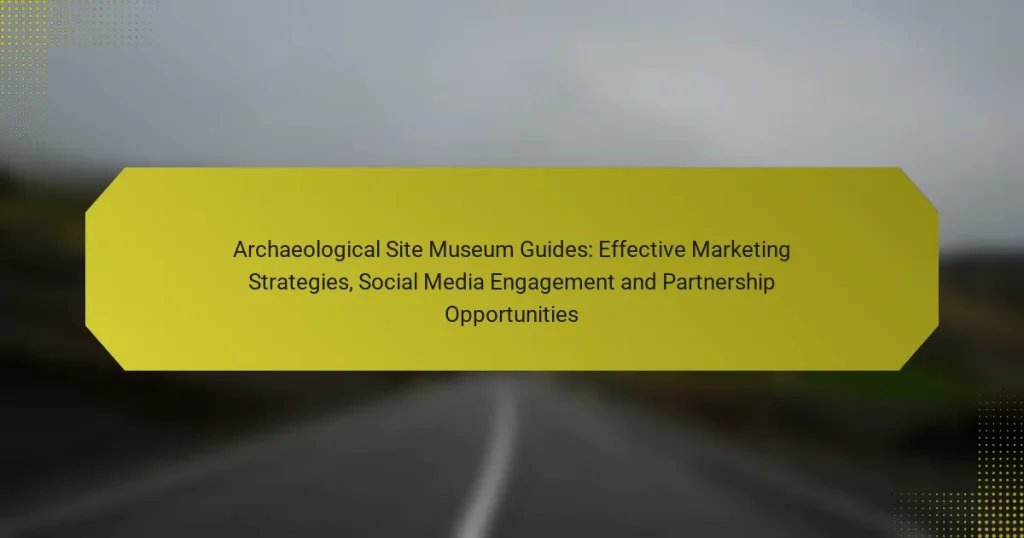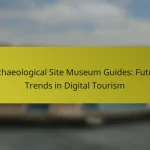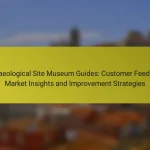Archaeological site museums can enhance their visibility and visitor engagement through effective marketing strategies that emphasize storytelling, collaboration, and targeted outreach. By leveraging social media platforms, these museums can create interactive experiences that connect with broader audiences and foster community involvement. Additionally, forming partnerships with local organizations can further amplify their impact and resources, creating a win-win scenario for both the museum and the community.
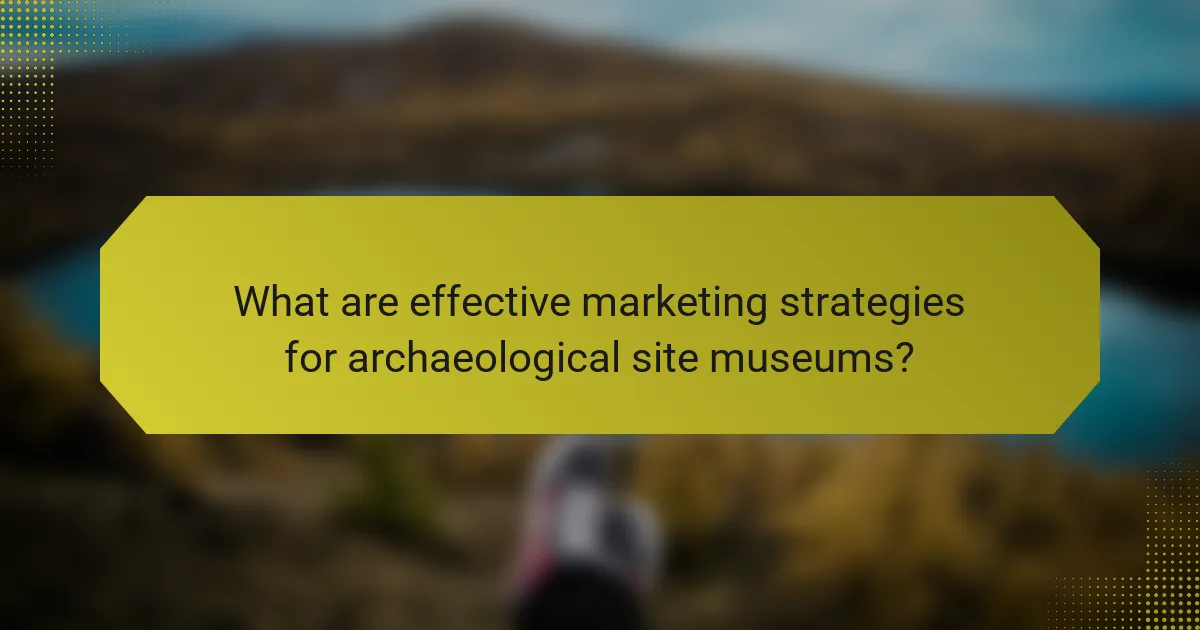
What are effective marketing strategies for archaeological site museums?
Effective marketing strategies for archaeological site museums focus on engaging audiences through storytelling, collaboration, targeted outreach, and partnerships. These approaches can enhance visibility, attract visitors, and foster community connections.
Content marketing through storytelling
Content marketing through storytelling involves sharing compelling narratives about the archaeological site’s history, discoveries, and significance. This can be achieved through blog posts, videos, and social media updates that highlight unique artifacts and their stories.
Utilizing various formats, such as podcasts or interactive online exhibits, can further engage audiences. Aim to create content that resonates emotionally, making the history accessible and relatable to visitors of all ages.
Collaborative events with local schools
Collaborative events with local schools can significantly boost community engagement and awareness of the museum. Organizing field trips, workshops, or educational programs allows students to experience the site firsthand and learn about archaeology in a practical setting.
Consider offering special discounts or free admission for school groups, which can encourage participation. Building relationships with educators can lead to ongoing partnerships that promote the museum as a valuable educational resource.
Targeted email campaigns
Targeted email campaigns are an effective way to reach specific audience segments, such as previous visitors, local residents, or history enthusiasts. Craft personalized messages that highlight upcoming events, exhibitions, or educational opportunities relevant to each group.
Utilize segmentation strategies to tailor content based on interests or demographics. Regular newsletters can keep your audience informed and engaged, increasing the likelihood of repeat visits and word-of-mouth referrals.
Influencer partnerships in heritage tourism
Influencer partnerships in heritage tourism can amplify your museum’s reach and credibility. Collaborate with travel bloggers, historians, or cultural influencers who share a passion for archaeology and heritage, inviting them to experience the site and share their insights with their followers.
Choose influencers whose audience aligns with your target demographic. This strategy can enhance visibility and attract new visitors, especially if influencers create engaging content that showcases the museum’s unique offerings.
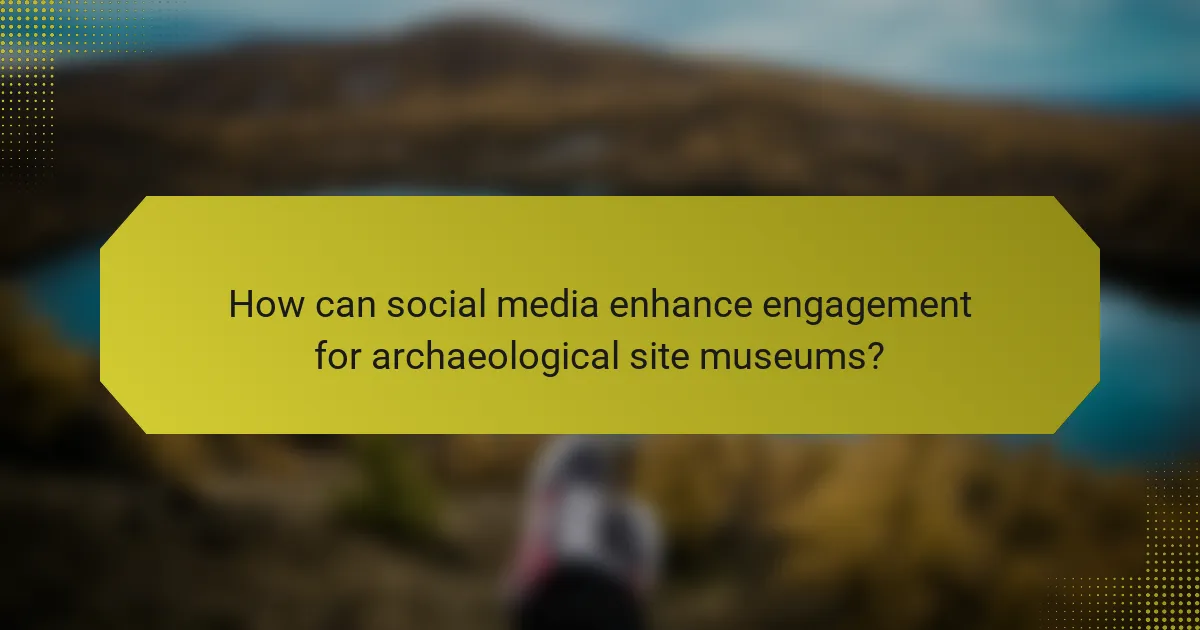
How can social media enhance engagement for archaeological site museums?
Social media can significantly boost engagement for archaeological site museums by creating interactive platforms for storytelling and community involvement. By leveraging various social media channels, museums can reach broader audiences, share captivating content, and foster a sense of connection with their visitors.
Utilizing Instagram for visual storytelling
Instagram is an ideal platform for archaeological site museums to showcase stunning visuals of artifacts, exhibits, and the sites themselves. High-quality images and engaging captions can draw in users, making them feel as though they are part of the experience. Regular posts, stories, and reels can keep followers updated on new findings or events.
Consider using Instagram’s features like polls and questions in stories to encourage interaction. This not only boosts engagement but also provides valuable feedback from your audience about what they find most interesting.
Facebook Live tours and Q&A sessions
Facebook Live offers a unique opportunity for archaeological site museums to conduct virtual tours and live Q&A sessions. These events allow viewers to explore the site in real-time, ask questions, and interact with experts, creating a personal connection. Schedule these sessions during peak engagement times, typically evenings or weekends, to maximize attendance.
Promote these live events in advance through posts and stories to build anticipation. After the session, share highlights or a recorded version to reach those who couldn’t attend live, ensuring continued engagement.
Engaging TikTok challenges related to history
TikTok can be a powerful tool for archaeological site museums to engage younger audiences through creative challenges and trends. By creating fun and educational challenges related to historical themes or artifacts, museums can encourage users to participate and share their own content. This not only raises awareness but also fosters a community around shared interests in history.
Consider collaborating with popular TikTok creators who focus on educational content to expand your reach. Keep challenges simple and relatable, allowing participants to express their creativity while learning about archaeology.

What are the best practices for partnerships with local organizations?
Effective partnerships with local organizations can enhance the visibility and impact of archaeological site museums. Building strong relationships with community entities fosters collaboration, resource sharing, and mutual benefits.
Collaborations with universities for research
Partnering with universities can provide valuable research opportunities and access to academic resources. These collaborations often involve joint studies, internships, and educational programs that benefit both the museum and the academic institution.
Consider establishing agreements that allow students to conduct fieldwork or internships at the museum. This not only enriches their education but also brings fresh insights and energy to your organization.
Joint marketing with local tourism boards
Working with local tourism boards can amplify your marketing efforts and attract more visitors. Joint marketing initiatives can include shared advertising campaigns, promotional materials, and bundled ticket offerings that highlight both the museum and nearby attractions.
To maximize effectiveness, align your marketing strategies with the tourism board’s goals. Regular meetings to discuss upcoming events and promotions can ensure that both parties benefit from increased visibility and visitor engagement.
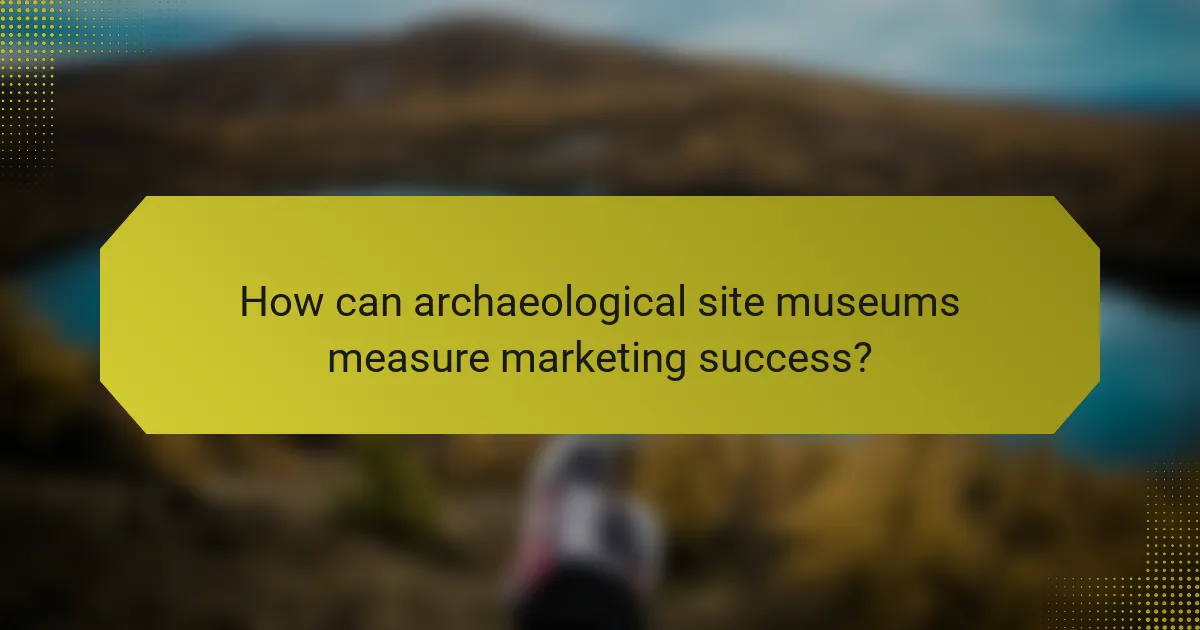
How can archaeological site museums measure marketing success?
Archaeological site museums can measure marketing success by evaluating visitor engagement and analyzing social media interactions. These metrics provide insights into how effectively marketing strategies attract and retain visitors, guiding future efforts.
Tracking visitor engagement metrics
To track visitor engagement metrics, museums should focus on key indicators such as attendance numbers, visitor demographics, and time spent at exhibits. Tools like ticketing systems and visitor surveys can help gather this data effectively.
Consider using visitor tracking technology, such as heat maps or mobile apps, to understand which exhibits draw the most interest. This information can inform future marketing campaigns and exhibit designs, ensuring resources are allocated efficiently.
Regularly reviewing engagement metrics allows museums to identify trends and adjust their strategies accordingly. For example, if a particular exhibit consistently attracts more visitors, targeted promotions can be developed to highlight similar themes or artifacts.
Analyzing social media interaction rates
Analyzing social media interaction rates involves measuring likes, shares, comments, and overall engagement on platforms like Facebook, Instagram, and Twitter. These metrics reveal how well content resonates with the audience and can indicate the effectiveness of marketing campaigns.
Utilize social media analytics tools to track performance over time, comparing different types of posts to see what generates the most interest. For instance, visual content such as videos or behind-the-scenes photos may yield higher engagement than standard text posts.
Engagement rates can also guide content strategy. If posts about specific exhibits receive more interaction, consider creating additional content around those themes or even hosting live Q&A sessions to deepen audience engagement.
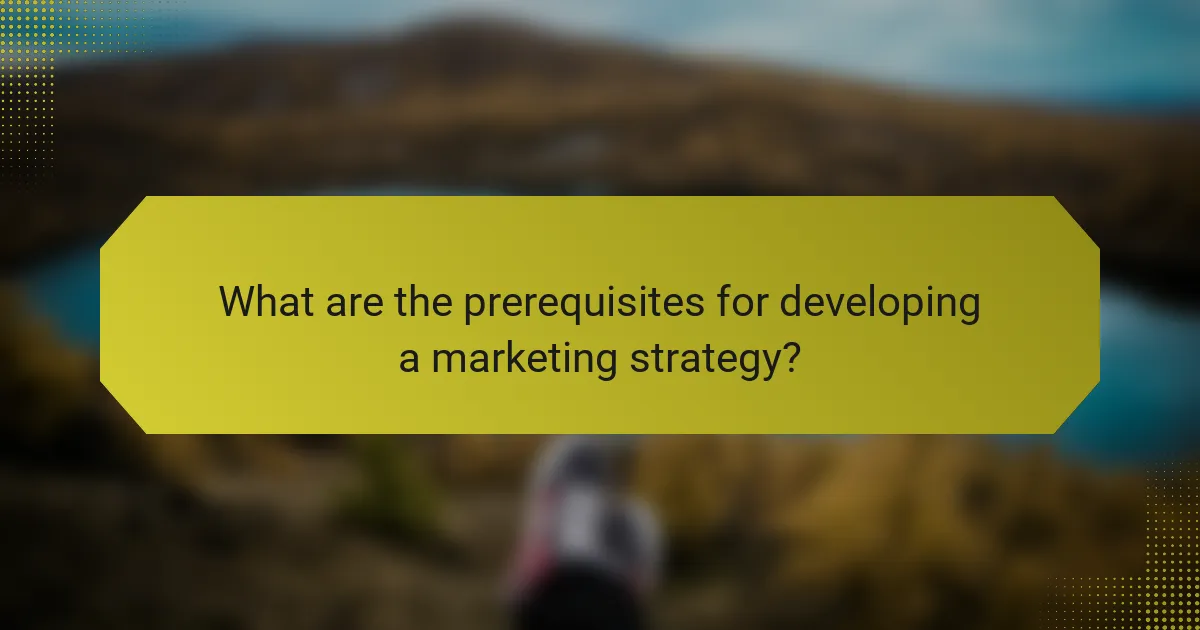
What are the prerequisites for developing a marketing strategy?
To develop an effective marketing strategy for an archaeological site museum, it’s essential to understand your audience, set clear objectives, and assess available resources. These prerequisites lay the foundation for targeted and impactful marketing efforts.
Understanding target audience demographics
Identifying the demographics of your target audience is crucial for tailoring your marketing strategy. Consider factors such as age, interests, education level, and geographic location. For instance, families with children may be more interested in interactive exhibits, while academic visitors might seek in-depth historical information.
Utilize surveys, social media analytics, and visitor feedback to gather data on your audience. This information can help you create personas that represent your typical visitors, allowing for more personalized marketing campaigns.
Defining clear marketing goals
Establishing clear marketing goals is vital for measuring success and guiding your strategy. Goals should be specific, measurable, achievable, relevant, and time-bound (SMART). For example, a goal could be to increase visitor numbers by 20% over the next year or to boost social media engagement by 30% in six months.
Regularly review and adjust your goals based on performance metrics. This iterative approach ensures that your marketing efforts remain aligned with your audience’s needs and the museum’s objectives, ultimately enhancing visitor experience and satisfaction.
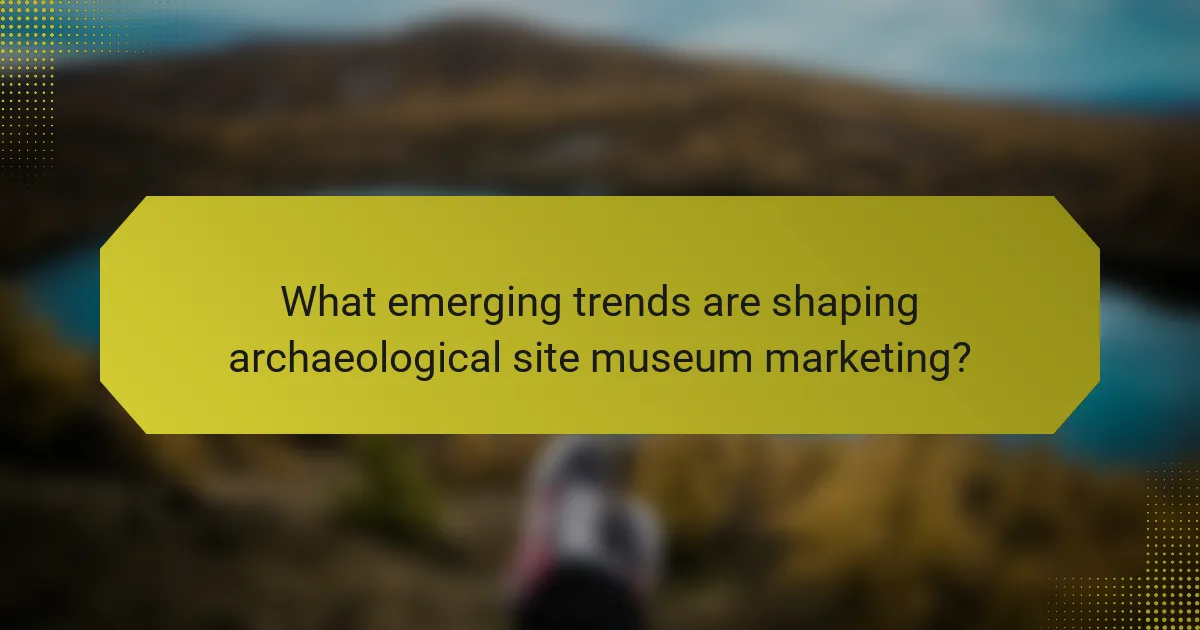
What emerging trends are shaping archaeological site museum marketing?
Emerging trends in archaeological site museum marketing focus on enhancing visitor engagement through technology, social media, and partnerships. These strategies aim to attract a diverse audience and create immersive experiences that foster a deeper connection with history.
Integration of augmented reality experiences
Augmented reality (AR) experiences are becoming a key component of marketing strategies for archaeological site museums. By overlaying digital information onto physical exhibits, AR can enhance storytelling and provide interactive learning opportunities for visitors.
To implement AR effectively, museums should consider user-friendly applications that can be accessed via smartphones or tablets. Collaborating with tech companies can help create engaging content that highlights significant artifacts or historical events, making the experience more memorable.
For example, a museum could develop an AR app that allows visitors to see reconstructions of ancient structures as they explore the site. This not only enriches the visitor experience but also encourages social sharing, increasing the museum’s visibility online.
